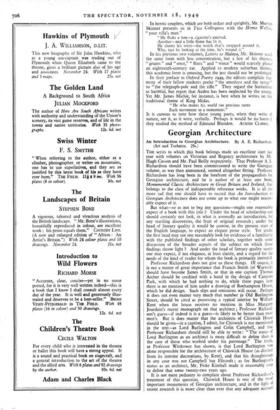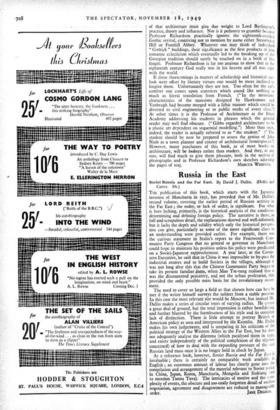Georgian Architecture
An Introduction to Georgian Architecture. By A. E. Richardson. (Art and Technics. 25s.)
THE series to which this book belongs made an excellent start last year with volumes on Victorian and Regency architecture by Mr. Hugh Casson and Mr. Paul Reilly respectively. That Professor A. E. Richardson should have been commissioned to write the Georgian volume, as was then announced, seemed altogether fitting. Professor Richardson has long been in the forefront of the propagandists for Georgian architecture, and he is author of at least one book, Monumental Classic Architecture in Great Britain and Ireland, that belongs to the class of indispensable reference works. It is all the more sad that one should have to record that An Introduction r) Georgian Architecture does not come up to what one might reason-
ably expect of it. •
But what—so as not to beg any questions—might one reasonably expect of a book with this title ? Under the head of scholarship one should certainly not look, in what is avowedly an introduction, for any startling discoveries, the fruit of original research ; under the head of literary quality it would be unwise, in the present state of the English language, to expect an elegant prose style. Yet under the first head may not one reasonably look for evidence of a familiarity with the published findings of other scholars, together with some discussion of the broader aspects of the subject on which those findings throw light ? And under the head of literary quality surely one may expect, if not elegance, at least clarity, and a regard for the needs of the kind of reader for whom the book is primarily intended. Professor Richardson does not give us these things. Of course, it is not a matter of great importance that Francis Smith (of Warwick) should have become James Smith, or that in one caption Thomas Archer should be credited with a hand in the design of Cannons Park, with which he had nothing to do, while three pages later there is no mention of him under a drawing of Roehampton House, which he did design. Such slips and omissions will occur. Perhaps it does not even matter very much that number 31 Old Burlington Street, should be cited as possessing a typical interior by William Kent when the house receives no mention in Miss Margaret jourdain's recent monograph on that architect ; Professor Richard- son's guess—if indeed it is a guess—is likely to be better than most men's. But it does matter that the architects of Chiswick House should be given—in a caption, I admit, for Chiswick is not mentioned in the text—as Lord Burlington and Colin Campbell, and thif Professor Richardson should still be able to write: "The status of Lord Burlington as an architect is more difficult to define than is the case of those who worked under his patronage." The truth, as Professor Wittkower has shown, is that Lord Burlington
alone responsible for the architecture of Chiswick House (as distinct from its interior decorations, by Kent), and that his draughtsman in any case was not Campbell but Flitcroft ; as for Burlington's status as an architect, Mr. Fiske Kimball made it reasonably easY to define that some twenty-two years ago. It is not mere pedantry to complain about Professor Richardson's treatment of this question. Chiswick House is one of the molt important monuments of Georgian architecture, and in the light of recent research it is more clear than ever that any adequate account
of that architecture must give due weight to Lord Burlington's practice, theory and influence. Nor is it pedantry to grumble Ix\ Professor Richardson practically ignores the eighteenth-centucy Gothic revival, contriving not to mention by name either Strawbeiiy Hill or Foothill Abbey. Whatever one may think of individual " Gothick " buildings, their significance as the first products of 'dim romantic eclecticism which eventually led to the breaking up of the Georgian tradition should surely be touched on in a book of 'chit length. Professor Richardson is far too anxious to show that in the eighteenth century God really was in his heaven and all was right with the world.
If these shortcomings in matters of scholarship and historical out. look were offset by literary virtues one would be more inclined to forgive them. Unfortunately they are not. Too often for the ear's comfort one comes upon sentences which sound like nothing much as literal translation from French. (" In the meantime characteristics of the mansions designed by Hawksmoor and Vanbrugh had become merged with a lithic manner which could be diverted to civil engineering or to public works of every class.") At other times it is the Professor of Architecture at the Royal Academy addressing his students in phrases which the general reader may well find obscure. (" Gibbs regarded architecture to be a plastic art dependent on sequential modelling.") More than once, indeed, the reader is actually referred to as " the student." ("The student should by now be prepared to assess the genius of John Nash as a town planner and creator of architectural frontispieces.") However, many purchasers of this book, as of most books on architecture, will be lookers rather than readers. And they, at any rate, will find much to give them pleasure, both in the section of photographs and in Professor Richardson's own sketches adornin; the pages of text. MARCUS WIRFELNI.















































































 Previous page
Previous page